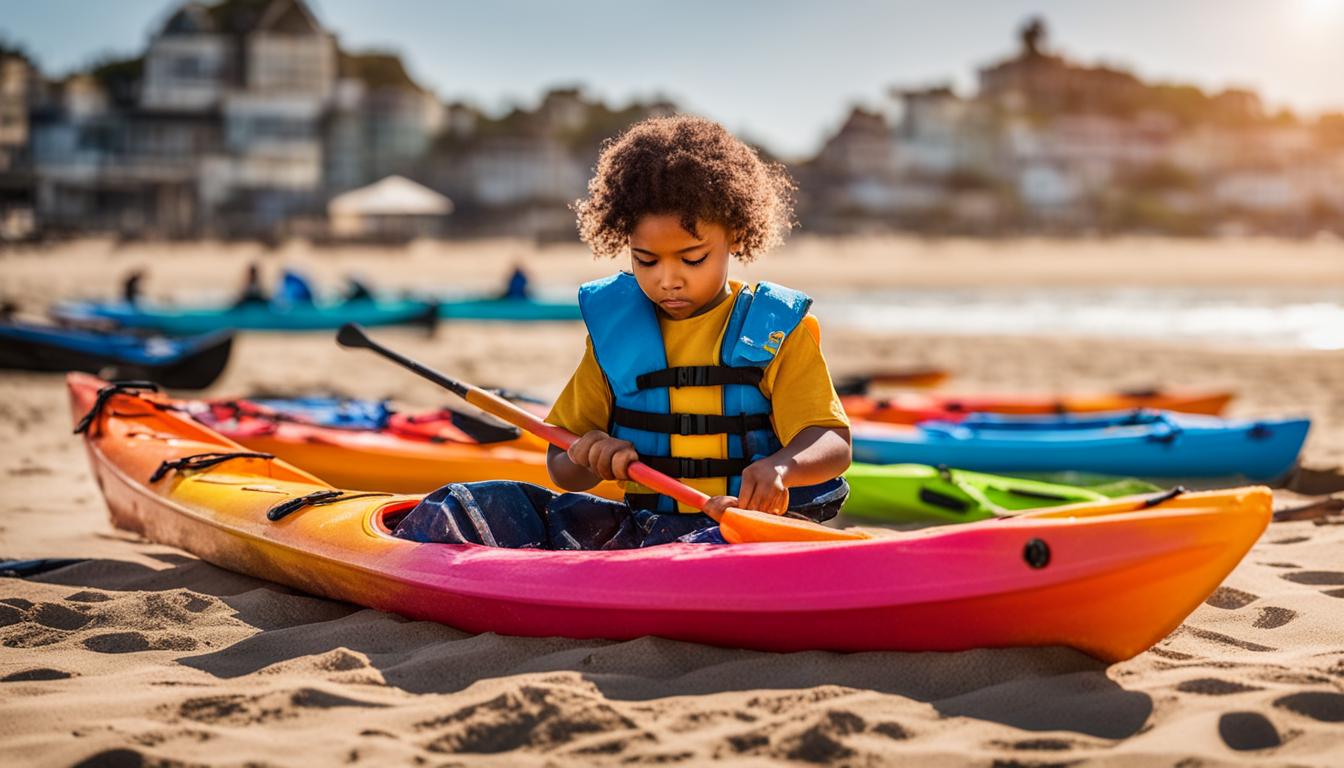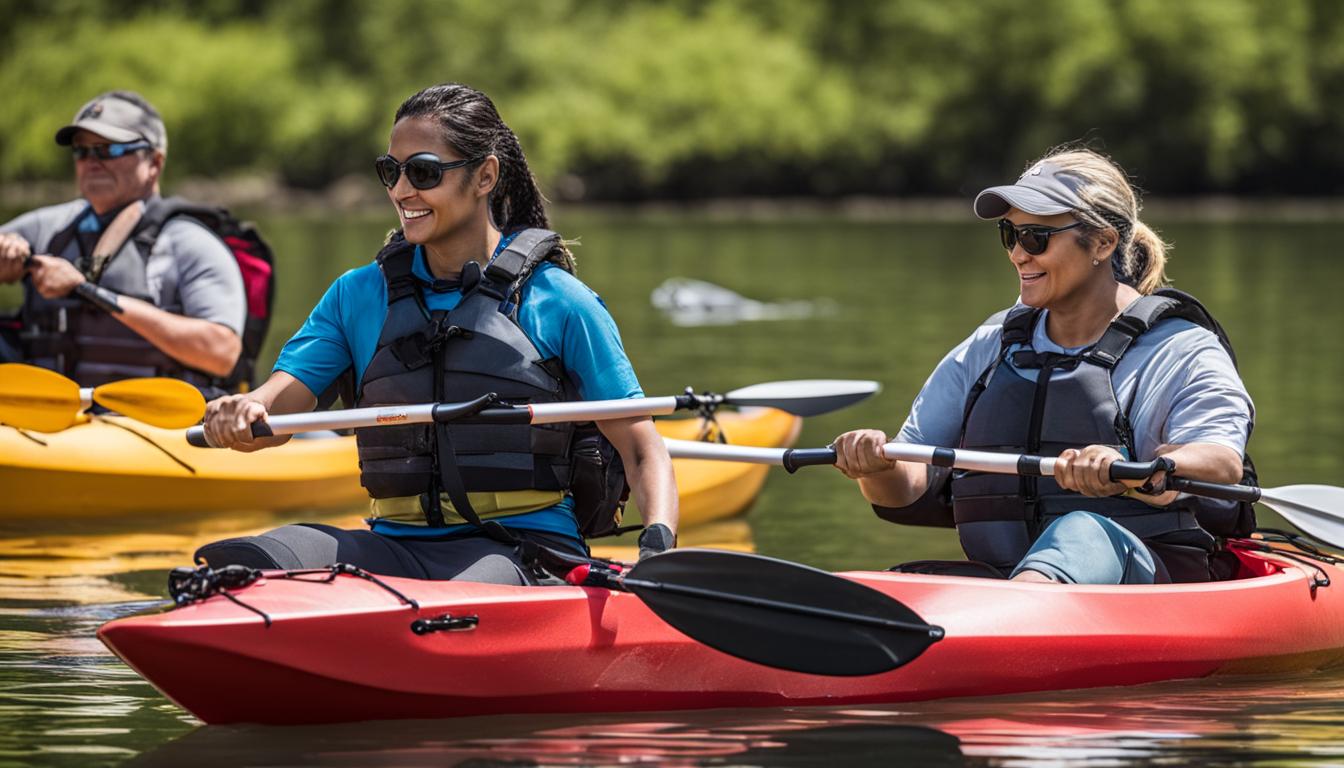When it comes to choosing a kayak for your child, you want to make sure you’re picking the right one. One of the first decisions you’ll face is whether to go with an inflatable or a hard-shell kayak. Inflatables offer lightweight portability and budget-friendly options, while hard-shells are known for their durability. Let’s dive deeper into the pros and cons of each type to help you make an informed decision for your young paddler.
Key Takeaways:
- Inflatable kayaks are lightweight, portable, and often more affordable for young paddlers.
- Hard-shell kayaks are known for their durability and can withstand rough water conditions.
- Consider factors such as safety, durability, ease of use, and cost when choosing the right kayak for your child.
- Inflatable kayaks are made of materials like PVC, Hypalon, or Nitrylon and gain rigidity through air pressure.
- Hard-shell kayaks are made of rigid materials like polyethylene plastic, fiberglass, kevlar, or thermoformed ABS.
Kayak Materials: Inflatable vs Hard-Shell
When comparing inflatable and hard-shell kayaks, the materials used in their construction play a significant role. Hard-shell kayaks are made of rigid materials such as polyethylene plastic, fiberglass, kevlar, and thermoformed ABS. These materials provide durability but also make the kayaks heavy, weighing around 50-60 pounds. In contrast, inflatable kayaks are much lighter, weighing an average of 25 pounds. They are made of PVC, Hypalon, or Nitrylon, gaining rigidity through air pressure. Inflatable kayaks also feature woven layers of high-quality fabrics like neoprene, making them sturdy and durable.
One of the key benefits of inflatable kayak materials is their lightweight nature. This factor makes them easier to carry and transport, especially for children or families who may struggle with the heavier weight of hard-shell kayaks. The use of PVC, Hypalon, and Nitrylon not only reduces the overall weight but also provides a level of flexibility. Inflatable kayaks can absorb impact and bend slightly on rough waters, ensuring a more comfortable experience for young paddlers.
Hard-shell kayaks, on the other hand, are known for their rigidness and durability. The materials used in their construction offer excellent resistance to impacts from rocks and debris. This makes hard-shell kayaks a suitable option for young beginners who may be more prone to accidental collisions. However, it’s important to note that advancements in inflatable kayak technology have significantly improved their durability, making them a viable choice for children as well.
| Kayak Type | Materials | Weight | Durability |
|---|---|---|---|
| Inflatable Kayaks | PVC, Hypalon, Nitrylon | Approximately 25 pounds | Sturdy and durable with woven layers of high-quality fabrics |
| Hard-Shell Kayaks | Polyethylene plastic, fiberglass, kevlar, thermoformed ABS | Approximately 50-60 pounds | Rigid and durable, excellent resistance to impacts |
Overall, the choice between inflatable and hard-shell kayaks will depend on factors such as the age and experience of the child, the type of water they will be paddling in, and personal preferences. While hard-shell kayaks offer superior rigidity and durability, inflatable kayaks provide a lightweight and flexible option with advancements in material technology. Consider the specific needs and requirements of your child before making a decision, keeping in mind that both types of kayaks can provide enjoyable and safe experiences on the water.
Durability: Inflatable vs Hard-Shell Kayaks
When it comes to the durability of kayaks for children, both inflatable and hard-shell options have their advantages. While hard-shell kayaks are generally known for their durability, modern inflatable kayaks have improved significantly in this aspect.
Hard-shell kayaks are made of rigid materials such as polyethylene plastic, fiberglass, kevlar, and thermoformed ABS, which provide excellent resistance to impacts and rough water conditions. They can handle encounters with rocks and debris without significant damage.
On the other hand, high-quality inflatable kayaks made of Hypalon and PVC have proven to be equally resilient. These materials are designed to endure abrasions from rocks and debris, making them suitable for adventurous young paddlers. However, it’s important to note that inflatable kayaks might require extra care to prevent punctures or tears, such as avoiding sharp objects and properly storing them when not in use.
“We’ve been using our inflatable kayak with our kids for years, and it has held up remarkably well. We’ve taken it on rivers, lakes, and even some coastal excursions without any issues. Just make sure to follow the maintenance instructions, and you’ll have a durable and safe kayak for your children.” – Experienced Parent
Ultimately, the decision between inflatable and hard-shell kayaks for children’s durability will depend on the specific needs and preferences of the family. It’s important to consider the type of water conditions your child will be paddling in and the level of maintenance you are willing to undertake to ensure the longevity of the kayak.
Maintenance Tips for Kids’ Hard-Shell Kayaks:
- Rinse the kayak with fresh water after each use to remove any salt or dirt that could cause damage.
- Inspect the kayak regularly for any cracks or signs of wear and promptly repair them to avoid further damage.
- Store the kayak in a cool, dry place to prevent UV damage and deformations due to temperature changes.
- Consider using kayak covers or protective bags to shield the kayak from scratches during transportation and storage.
Maintenance Tips for Inflatable Kayaks:
- Avoid sharp objects and abrasive surfaces that could puncture or tear the kayak.
- Clean the kayak with mild soap and water after each use to remove dirt and debris.
- Thoroughly dry the kayak before deflating and storing it to prevent mold or mildew growth.
- Inspect the kayak for any signs of punctures or leaks before each use, and repair them promptly using a patch kit.
| Hard-Shell Kayaks | Inflatable Kayaks | |
|---|---|---|
| Resistance to impacts | Excellent | Good |
| Resistance to abrasions | Excellent | Good |
| Maintenance requirements | Minimal | Regular inspections and care |
| Repairability | Easily repairable | Easily repairable with patch kits |
Table: A comparison of durability factors between hard-shell and inflatable kayaks for children.

Cost: Inflatable vs Hard-Shell Kayaks
| Kayak Type | Price Range |
|---|---|
| Inflatable Kayaks | Affordable |
| Hard-Shell Kayaks | Expensive |
When it comes to the cost, inflatable kayaks offer a significant advantage over hard-shell kayaks. Inflatable kayaks come in various price ranges, making them accessible to different budgets. They are generally more affordable than hard-shell kayaks, which can cost thousands of dollars. Whether you’re looking for a budget-friendly option or want to save some money, inflatable kayaks provide a more cost-effective choice for families.
Not only are inflatable kayaks affordable, but they also come with additional cost-saving benefits. For example, their portability makes them convenient for families who want to avoid the need for expensive roof racks or storage solutions. Inflatables can be easily deflated and packed into a bag, taking up minimal storage space. This means you won’t have to worry about finding indoor storage or paying for extra storage options.
Hard-shell kayaks, on the other hand, can be quite expensive. While they provide durability and superior performance on the water, the high price tag might not be suitable for every budget. Consider your budget and weigh the cost against the other factors when choosing the right kayak type for your child.
Portability and Storage: Inflatable vs Hard-Shell Kayaks
When it comes to portability and storage, inflatable kayaks have a clear advantage over their hard-shell counterparts. Their lightweight and collapsible design make them easy to transport and store, making them a great option for families with kids. Inflatable kayaks can be deflated and packed into a bag, allowing you to take them on hikes, camping trips, or even on an airplane. They can easily fit into the trunk of your car without the need for roof racks or complicated loading and unloading procedures.
Hard-shell kayaks, on the other hand, require more space for storage and can be more challenging to transport. They are bulky and heavy, often weighing around 50-60 pounds. This makes them less suitable for families with young beginners or parents who want to have the flexibility to take their kayaks on outdoor adventures. Hard-shell kayaks may also require indoor storage for security purposes, which can be inconvenient if you have limited space.
The portability of inflatable kayaks makes them an ideal choice for families looking for easy-to-store kayaks for kids. Their lightweight and collapsible design allow for hassle-free transportation and storage.
Overall, if you prioritize ease of transport and storage, inflatable kayaks are the way to go. They offer unparalleled convenience and flexibility, especially for families who love outdoor activities. Hard-shell kayaks, while durable and reliable, may be more suitable for experienced paddlers or those who prioritize performance on the water over portability and storage.

| Inflatable Kayaks | Hard-Shell Kayaks | |
|---|---|---|
| Portability | Lightweight and collapsible design | Bulky and heavy |
| Transportation | Easy to fit in a car trunk | May require roof racks or specialized equipment |
| Storage | Can be deflated and packed into a bag | Requires more storage space |
“Inflatable kayaks offer unparalleled convenience and flexibility, especially for families who love outdoor activities.”
In summary, if you’re looking for easy-to-store kayaks for kids, inflatable kayaks are the way to go. They combine lightweight portability with durability, making them a great choice for families. Hard-shell kayaks, although known for their performance on the water, can be more challenging to transport and require more storage space.
Performance on the Water: Inflatable vs Hard-Shell Kayaks
When it comes to performance on the water, hard-shell kayaks have long been considered the gold standard. Their rigid construction and design provide excellent maneuverability, stability, and tracking, making them a popular choice for experienced paddlers. Hard-shell kayaks offer better control in rough waters and windy conditions, allowing for more precise navigation.
However, inflatable kayaks have made significant strides in performance over the years. With advancements in technology and design, inflatable kayaks can now offer comparable performance to their hard-shell counterparts. Many high-quality inflatable kayaks come equipped with features like skegs and attachments for increased stability and improved tracking, even in challenging conditions. These enhancements have made inflatable kayaks a suitable option for paddlers of all skill levels, including young beginners.
It’s important to note that while inflatable kayaks can provide a satisfactory level of performance, they may not match the absolute performance capabilities of hard-shell kayaks in certain situations. Factors such as the type of water, weather conditions, and intended use should be taken into account when deciding between the two. For leisurely recreational paddling or calm waters, inflatable kayaks can provide an enjoyable and safe experience for children.
Inflatable kayaks have come a long way in terms of performance. They offer stability, maneuverability, and tracking that rival traditional hard-shell kayaks. With the right inflatable kayak designed for specific purposes, such as fishing or whitewater kayaking, young beginners can have a safe and thrilling experience on the water.
Comparing Performance: Inflatable vs Hard-Shell Kayaks
| Inflatable Kayaks | Hard-Shell Kayaks | |
|---|---|---|
| Maneuverability | Good | Excellent |
| Stability | Good | Excellent |
| Tracking | Good | Excellent |
| Control in Rough Waters | Fair | Excellent |
| Control in Windy Conditions | Fair | Excellent |
As the table shows, while inflatable kayaks offer good performance in terms of maneuverability, stability, and tracking, hard-shell kayaks excel in all areas. Their superior control in rough waters and windy conditions makes them the preferred choice for advanced paddlers. However, for young beginners or recreational paddlers in calm waters, inflatable kayaks can provide a fun and safe experience.
Conclusion
When it comes to choosing the right kayak for your child, there are several factors to consider. Both inflatable and hard-shell kayaks have their strengths and weaknesses, so it’s important to weigh your options.
Inflatable kayaks offer lightweight portability and affordability, making them a great choice for families on a budget or those who love to travel. They are easy to transport and store, and their durability has significantly improved over the years. On the other hand, hard-shell kayaks are known for their superior performance on the water. They provide stability, maneuverability, and tracking, making them ideal for young beginners.
Ultimately, the decision boils down to your specific needs and preferences. Consider the type of water your child will be kayaking on, the available storage space, and your budget. Whether you choose an inflatable or hard-shell kayak, rest assured that kayaking will provide incredible adventures and lasting memories for your child.
FAQ
What are the advantages of inflatable kayaks for kids?
Inflatable kayaks are lightweight, price-efficient, and portable, making them a suitable choice for young paddlers.
Are hard-shell kayaks more durable than inflatable kayaks?
While hard-shell kayaks are known for their durability, advancements in inflatable kayak technology have made them equally resilient.
Are inflatable kayaks more affordable than hard-shell kayaks?
Yes, inflatable kayaks are generally more cost-effective compared to hard-shell kayaks, making them accessible to different budgets.
Which type of kayak is easier to transport and store?
Inflatable kayaks have the advantage of being easily deflated and packed into a bag, making them convenient for transportation and storage.
Do hard-shell kayaks offer better performance on the water?
Hard-shell kayaks are known for their superior maneuverability, stability, and tracking, but inflatable kayaks have made significant advancements in performance.
How do I choose between inflatable and hard-shell kayaks for my child?
The choice depends on factors such as your specific needs, preferences, safety, durability, ease of use, and cost. Considering the type of water, storage space, and budget can help you make an informed decision.





